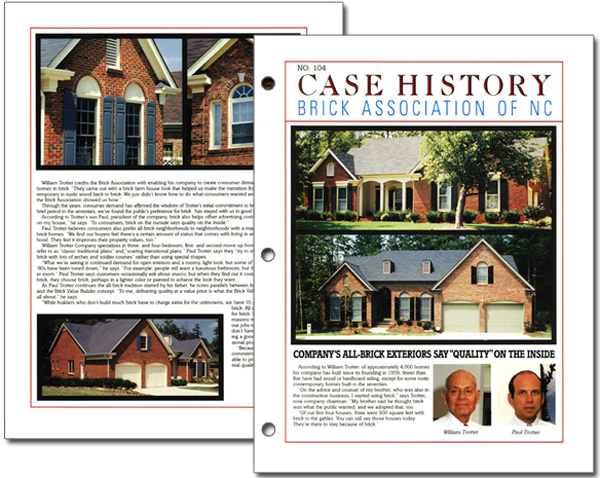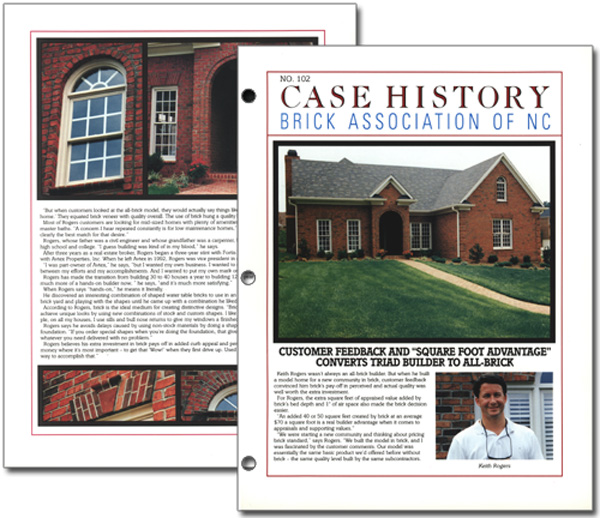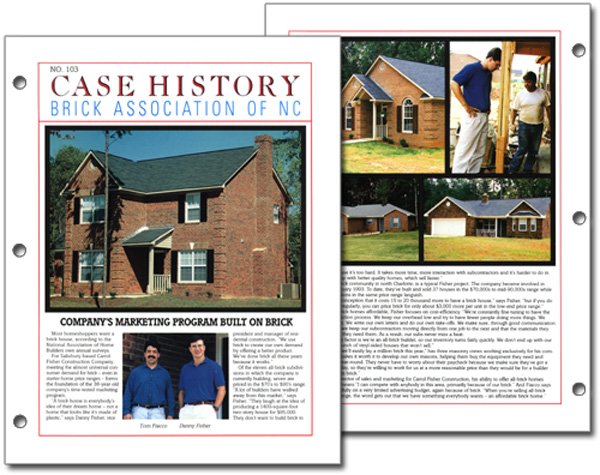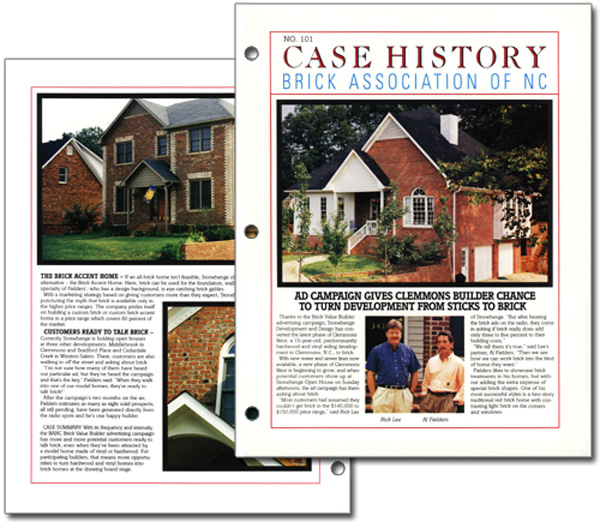Builder Case Studies
Company’s All-Brick Exteriors Say “Quality” on the Inside

According to William Trotter, of approximately 4,000 homes his company has built since its founding in 1959, fewer than five have had wood or hardboard siding, except for some rustic contemporary homes built in the seventies.
“On the advice and counsel of my brother, who was also in the construction business, I started using brick,” says Trotter, now company chairman. “My brother said he thought brick was what the public wanted, and we adopted that, too.
“Of our first four houses, three were 900 square feet with brick to the gables. You can still see those houses today. They’re there to stay because of brick.”
William Trotter credits the Brick Association with enabling his company to create consumer demand for contemporary homes in brick. “They came out with a brick farm house look that helped us make the transition from the seventies contemporary in rustic wood back to brick. We just didn’t know how to do what consumers wanted architecturally, and then the Brick Association showed us how.”
Through the years, consumer demand has affirmed the wisdom of Trotter’s initial commitment to brick. “Except for that brief period in the seventies, we’ve found the public’s preference for brick has stayed with us in good times and bad.”
According to Trotter’s son Paul, president of the company, brick also helps offset advertising costs. “My advertising is on my house,” he says. “To consumers, brick on the outside says quality on the inside.”
Paul Trotter believes consumers also prefer all-brick neighborhoods to neighborhoods with a mixture of siding and brick homes. “We find our buyers feel there’s a certain amount of status that comes with living in an all-brick neighborhood. They feel it improves their property values, too.”
William Trotter Company specializes in three- and four-bedroom, first- and second-move-up homes using what they refer to as “classic traditional plans” and “soaring transitional plans.” Paul Trotter says they “try to stick with standard brick with lots of arches and soldier courses” rather than using special shapes.
“What we’re seeing is continued demand for open interiors and a roomy, light look, but some of the excesses of the ‘80s have been toned down,” he says. “For example, people still want a luxurious bathroom, but they don’t want a locker room.” Paul Trotter says customers occasionally ask about stucco, but when they find out it costs about the same as brick, they choose brick, perhaps in a lighter color or painted to achieve the look they want.
As Paul Trotter continues the all-brick tradition started by his father, he notes parallels between his father’s philosophy and the Brick Value Builder concept. “To me, delivering quality at a value price is what the Brick Value Builder Program is all about,” he says.
“While builders who don’t build much brick have to charge extra for the unknowns, we have 35 years’ experience with brick. All our home plans are for brick. We have reliable masons moving from one of our jobs to the next, so we don’t have to worry about finding a good crew for an occasional project.
“Because we have a real commitment to brick, we’re able to provide our customers real quality and value.”
Customer Feedback and “Square Foot Advantage” Convert Triad Builder to All-Brick

Keith Rogers wasn’t always an all-brick builder. But when he built a model home for a new community in brick, customer feedback convinced him brick’s pay-off in perceived and actual quality was well worth the extra investment.
For Rogers, the extra square feet of appraised value added by brick’s bed depth and 1″ of air space also made the brick decision easier.
“An added 40 or 50 square feet created by brick at an average $70 a square foot is a real builder advantage when it comes to appraisals and supporting values.”
“We were starting a new community and thinking about having brick standard,” says Rogers. “We built the model in brick, and I was fascinated by the customer comments. Our model was essentially the same basic product we’d offered before without brick—the same quality level built by the same subcontractors.
“But when customers looked at the all-brick model, they would actually say things like, ‘I love the quality of this all-brick home.’ They equated brick veneer with quality overall. The use of brick hung a quality halo over the rest of the home.”
Most of Rogers customers are looking for mid-sized homes with plenty of amenities like high ceilings and lavish master baths. “A concern I hear repeated constantly is for low maintenance homes,” says Rogers. “Of course, brick is clearly the best match for that desire.”
Rogers, whose father was a civil engineer and whose grandfather was a carpenter, began working construction in high school and college. “I guess building was kind of in my blood,” he says.
After three years as a real estate broker, Rogers began a three-year stint with Fortis Homes, followed by seven years with Avtex Properties, Inc. When he left Avtex in 1992, Rogers was vice president in charge of home building.
“I was part-owner of Avtex,” he says, “but I wanted my own business. I wanted to see a more direct relationship between my efforts and my accomplishments. And I wanted to put my own mark on things.”
Rogers has made the transition from building 30 to 40 houses a year to building 12 a year with relative ease. “I’m much more of a hands-on builder now, “ he says, “and it’s much more satisfying.”
When Rogers says “hands-on,” he means it literally.
He discovered an interesting combination of shaped water table brick to use in an entrance archway by going to the brick yard and playing with the shapes until he came up with a combination he liked.
According to Rogers, brick is the ideal medium for creating distinctive designs. “Brick is very flexible in that you can achieve unique looks by using new combinations of stock and custom shapes. I like to use a lot of shapes. For example, on all my houses, I use sills and bull nose returns to give my windows a finished look.”
Rogers says he avoids delays caused by using non-stock materials by doing a shapes take-off when building the foundation. “If you order special shapes when you’re doing the foundation, that gives you a six-week lead time to get whatever you need delivered with no problem.”
Rogers believes his extra investment in brick pays off in added curb appeal and perceived quality. “I like to put my money where it’s most important—to get that ‘Wow!’ when they first drive up. Used creatively, brick is clearly the best way to accomplish that.”
Company’s Marketing Program Built on Brick

Most home shoppers want a brick house, according to the National Association of Home Builders own annual surveys.
For Salisbury-based Carroll Fisher Construction Company, meeting the almost universal consumer demand for brick—even in starter-home price ranges—forms the foundation of the 38-year-old company’s time-tested marketing program.
“A brick home is everybody’s idea of their dream home—not a home that looks like it’s made of plastic,” says Danny Fisher, vice-president and manager of residential construction. “We use brick to create our own demand by offering a better product. We’ve done brick all these years because it works.”
Of the eleven all-brick subdivisions in which the company is currently building, seven are priced in the $70s to $90s range. “A lot of builders have walked away from this market,” says Fisher. “They laugh, at the idea of producing a 1,400-square-foot two-story house for $95,000. They don’t want to build brick in this price range because it’s too hard. It takes more time, more interaction with subcontractors and it’s harder to do in winter, but you end up with better quality homes, which sell faster.”
SunTrace, an all-brick community in north Charlotte, is a typical Fisher project. The company became involved in SunTrace in late February 1993. To date, they’ve built and sold 37 houses in the $70,000s to mid-90,000s range while nearby vinyl subdivisions in the same price range languish.
“There’s a big misconception that it costs 15 to 20 thousand more to have a brick house,” says Fisher, “but if you do it right and you do it regularly, you can price brick for only about $3,000 more per unit in the low-end price range.”
To help keep his brick homes affordable, Fisher focuses on cost-efficiency. “We’re constantly fine-tuning to have the most efficient construction process. We keep our overhead low and try to have fewer people doing more things. We don’t have secretaries. We write our own letters and do our own take-offs. We make sure, through good communication and scheduling, that we keep our subcontractors moving directly from one job to the next and that the materials they need are there when they need them. As a result, our subs never miss a beat.
“Another important factor is we’re an all-brick builder, so our inventory turns fairly quickly. We don’t end up with our money tied up in a bunch of vinyl-sided houses that won’t sell.”
Fisher, who says “we’ll easily lay a million brick this year,” has three masonry crews working exclusively for his company. “Our volume makes it worth it to develop our own masons, helping them buy the equipment they need and keeping them busy year-round. They never have to worry about their paycheck because we make sure they’ve got a place to work every day, so they’re willing to work for us at a more reasonable price than they would be for a builder who’s only dabbling in brick.”
For Tom Fiacco, director of sales and marketing for Carrol Fisher Construction, his ability to offer all-brick homes starting in the $70s means, “I can compete with anybody in this area, primarily because of our brick.” And Fiacco says he competes successfully on a very limited advertising budget, again because of brick. “When you’re selling all-brick homes in this price range, the word gets out that we have something everybody wants—an affordable brick home.”
Ad Campaign Gives Clemmons Builder Chance to Turn Development from Sticks to Brick

Thanks to the Brick Value Builder advertising campaign, Stonehenge Development and Design has converted the latest phase of Clemmons West, a 15-year-old, predominantly hardwood and vinyl siding development in Clemmons, N.C., to brick.
With new water and sewer lines now available, a new phase of Clemmons West is beginning to grow, and when potential customers show up at Stonehenge Open House on Sunday afternoons, the ad campaign has them asking about brick.
“Most customers had assumed they couldn’t get brick in the $140,000 to $150,000 price range, said Rick Lee of Stonehenge. “But after hearing the brick ads on the radio, they come in asking if brick realty does add only three to five percent to their building costs.”
“We tell them it’s true,” said Lee’s partner, Al Fielders. “Then we see how we can work brick into the kind of home they want.”
Fielders likes to showcase brick treatments in his homes, but without adding the extra expense of special brick shapes. One of his most successful styles is a two-story traditional red brick home with contrasting light brick on the comers and windows.
The Brick Accent Home
If an all-brick home isn’t feasible, Stonehenge shows the customer an attractive alternative—the Brick Accent Home. Here, brick can be used for the foundation, walls, fireplace, steps and pavers. A specialty of Fielders, who has a design background, is eye-catching brick gables.
With a marketing strategy based on giving customers more than they expect, Stonehenge takes particular delight in puncturing the myth that brick is available only in the higher price ranges. The company prides itself on building a custom brick or custom brick accent home in a price range which covers 60 percent of the market.
Customers Ready to Talk Brick
Currently Stonehenge is holding open houses at three other developments: Middlebrook in Clemmons and Bradford Place and Cedardale Creek in Winston-Salem. There, customers are also walking in off the street and asking about brick.
“I’m not sure how many of them have heard our particular ad, but they’ve heard the campaign and that’s the key,” Fielders said. “When they walk into one of our model homes, they’re ready to talk brick!”
After the campaign’s two months on the air, Fielders estimates as many as eight solid prospects, all still pending, have been generated directly from the radio spots, and he’s one happy builder.
With its frequency and intensity, the BANC Brick Value Builder advertising campaign has more and more potential customers ready to talk brick, even when they’ve been attracted by a model home made of vinyl or hardwood. For participating builders, that means more opportunities to turn hardwood and vinyl homes into brick homes at the drawing board stage.
Return to the Brick Association of North Carolina main portfolio page
Let’s Talk About Your Marketing Communications Goals and Challenges!
If you’re looking for help with writing, graphic design and marketing communications and you like the portfolio samples you see here, contact me to schedule a telephone call to explore the possibilities of a collaboration. Of course, there is no cost or obligation for the call.